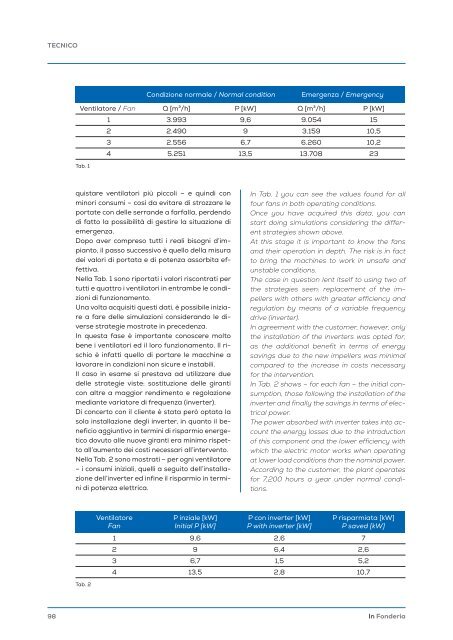In Fonderia 3 2023
Terzo numero del 2023 di In Fonderia
Terzo numero del 2023 di In Fonderia
You also want an ePaper? Increase the reach of your titles
YUMPU automatically turns print PDFs into web optimized ePapers that Google loves.
TECNICO<br />
Condizione normale / Normal condition<br />
Emergenza / Emergency<br />
Ventilatore / Fan Q [m³/h] P [kW] Q [m³/h] P [kW]<br />
1 3.993 9,6 9.054 15<br />
2 2.490 9 3.159 10,5<br />
3 2.556 6,7 6.260 10,2<br />
4 5.251 13,5 13.708 23<br />
Tab. 1<br />
quistare ventilatori più piccoli – e quindi con<br />
minori consumi – così da evitare di strozzare le<br />
portate con delle serrande a farfalla, perdendo<br />
di fatto la possibilità di gestire la situazione di<br />
emergenza.<br />
Dopo aver compreso tutti i reali bisogni d’impianto,<br />
il passo successivo è quello della misura<br />
dei valori di portata e di potenza assorbita effettiva.<br />
Nella Tab. 1 sono riportati i valori riscontrati per<br />
tutti e quattro i ventilatori in entrambe le condizioni<br />
di funzionamento.<br />
Una volta acquisiti questi dati, è possibile iniziare<br />
a fare delle simulazioni considerando le diverse<br />
strategie mostrate in precedenza.<br />
<strong>In</strong> questa fase è importante conoscere molto<br />
bene i ventilatori ed il loro funzionamento. Il rischio<br />
è infatti quello di portare le macchine a<br />
lavorare in condizioni non sicure e instabili.<br />
Il caso in esame si prestava ad utilizzare due<br />
delle strategie viste: sostituzione delle giranti<br />
con altre a maggior rendimento e regolazione<br />
mediante variatore di frequenza (inverter).<br />
Di concerto con il cliente è stata però optata la<br />
sola installazione degli inverter, in quanto il beneficio<br />
aggiuntivo in termini di risparmio energetico<br />
dovuto alle nuove giranti era minimo rispetto<br />
all’aumento dei costi necessari all’intervento.<br />
Nella Tab. 2 sono mostrati – per ogni ventilatore<br />
– i consumi iniziali, quelli a seguito dell’installazione<br />
dell’inverter ed infine il risparmio in termini<br />
di potenza elettrica.<br />
<strong>In</strong> Tab. 1 you can see the values found for all<br />
four fans in both operating conditions.<br />
Once you have acquired this data, you can<br />
start doing simulations considering the different<br />
strategies shown above.<br />
At this stage it is important to know the fans<br />
and their operation in depth. The risk is in fact<br />
to bring the machines to work in unsafe and<br />
unstable conditions.<br />
The case in question lent itself to using two of<br />
the strategies seen: replacement of the impellers<br />
with others with greater efficiency and<br />
regulation by means of a variable frequency<br />
drive (inverter).<br />
<strong>In</strong> agreement with the customer, however, only<br />
the installation of the inverters was opted for,<br />
as the additional benefit in terms of energy<br />
savings due to the new impellers was minimal<br />
compared to the increase in costs necessary<br />
for the intervention.<br />
<strong>In</strong> Tab. 2 shows – for each fan – the initial consumption,<br />
those following the installation of the<br />
inverter and finally the savings in terms of electrical<br />
power.<br />
The power absorbed with inverter takes into account<br />
the energy losses due to the introduction<br />
of this component and the lower efficiency with<br />
which the electric motor works when operating<br />
at lower load conditions than the nominal power.<br />
According to the customer, the plant operates<br />
for 7,200 hours a year under normal conditions.<br />
Ventilatore<br />
Fan<br />
P inziale [kW]<br />
<strong>In</strong>itial P [kW]<br />
P con inverter [kW]<br />
P with inverter [kW]<br />
P risparmiata [kW]<br />
P saved [kW]<br />
1 9,6 2,6 7<br />
2 9 6,4 2,6<br />
3 6,7 1,5 5,2<br />
4 13,5 2,8 10,7<br />
Tab. 2<br />
98<br />
<strong>In</strong> <strong>Fonderia</strong>














